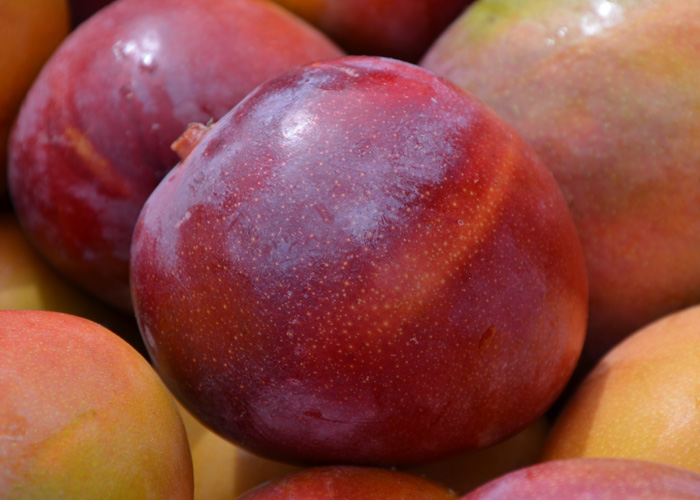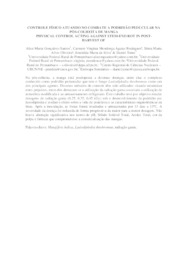Embrapa Agrobiology
 Busca de Notícias
Busca de Notícias
Researchers discover yeast against mango rot causing fungus
Photo: Fernanda Birolo

By replacing the application of chemicals, microorganism makes it possible to export the fruit to several countries
Scientists from Embrapa Environment found a yeast that controls Botryosphaeria dothidea, an important fungus that causes mango stem end rot. The microorganism is not controlled by conventional methods of agrochemical application or post-harvest thermal treatment. Therefore, the discovery by the researchers Bernardo Halfeld Vieira, Daniel Terao and Kátia Nechet is capable of generating a solution for the problem that does not leave chemical traces on the fruits, which is not only healthier but also avoids international barriers from countries that do not accept chemical treatments.
Vieira stresses that this pathogen can hinder mango exports in the first half of the year. This depends on weather conditions, especially rains at the time of blooming and the start of fructification.
The use of yeast in biocontrol has proven to be more efficient than the fungicide normally used in chemical treatment, tiabendazole. The production of an inhibitory substance by the yeast was not detected, hence the action does not involve an active principle.
The biological control agent Candida membranifaciens was the yeast that offered higher effectiveness when compared to the fruit treated with fungicide during an 11-day storage period. In contrast, the control fruits (untreated with fungicide or yeast) were completely rotten before the end of the experiment.
"There is not a cost estimate because only experimental tests have been made, a formulated product does not exist yet”, the researcher explains. Conventional treatment is solely based on fungicides. It combines hydrothermal treatment - the immersion of fruit in hot water -, with the use of fungicides, which leaves chemical traces and has not been effective in controlling the disease.
“The study demonstrated that competition combined with the formation of a layer of yeast in possible places of infection after colonization play an important role in reducing the severity of mango stem rot”, Vieira reports.
Fungicides lose effectivenessThe main problems of the massive use of fungicides is the contamination of the fruits with undesirable residue, and that they do not offer full protection against the rot. The fungi acquire resistance when the same fungicide is continuously used, making it lose effectiveness. Another problem is that there are few formulations registered for this purpose as well as a large variety of disease-causing fungi at the fruit post-harvest. There are basically three active principles registered for fruit treatment available: thiabendazole, imazalil and prochloraz. The first one has shown low efficiency as strains of resistant fungi have grown due to an extended, continuous use of the active principle. Most importing countries do not ban the use of prochloraz in the post-harvest. Daniel Terao explains that even though these products are registered for a few fruit species and to control a few fungal species, they have been used indiscriminately due to the lack of alternatives, despite not offering efficiency. |
Application
The researcher Daniel Terao prescribes combining the hydrothermal treatment with the subsequent application of the new biological product. The fruits should be first treated through hot water aspersion, over rolling brushes, at a suitable temperature and for a short period of time, in order to control the fungus without affecting fruit quality, and followed by cooling in cold water to interrupt the effect of the high temperature. After that, the biocontroller would be applied by sprinkling the yeast suspension through a spray, at the recommended concentration. The specialist emphasizes that the parameters and the protocol for the treatment are in a development phase.
Yeast competes with rot fungus
The results show that the mechanism responsible for the yeast's control of the disease is not related to antibiosis (action by substances produced by the yeast) or to parasitism. The scientists explain that the result is obtained because the yeast competes with the rot fungus, as it forms a film in the pathogen's infection spots. This forms a mechanical barrier between the surface of an occasional injury to the fruit skin and the pathogen, which promotes efficient biological control against post-harvest pathogens.
“The yeast can compete for the essential resources the rot fungus requires to grow, at a stage before pathogen penetration, affecting its ability to cause an infection”, details the Embrapa researcher.
As the fungus that causes stem rot remains quiescent, that is, dormant in the fruit until it starts to ripen, the yeast will be more efficient if it is present on the fruit skin while it is still green. Therefore, the symptoms are only observed during the post-harvest stage. Therefore the best way to perform the treatment would be by spraying a suspension of the microorganism's cells of on the unripened fruits, to control the disease and ensure the absence of toxic residue from fungicides in the fruits.
Vieira explains that they selected some yeasts that had already demonstrated biological control action from Embrapa Environment's collection. “We decided to test them for this mango disease as it is becoming very important. In addition to the tests, we had to learn how they exercise such control, that was our line of work.”
The researchers worked with live cells in laboratory. That is why the product has no formula yet."In theory that would not be complicated, the same sachet would be used, preserved in the long run, and developed to dissolve in water and to be used in a spray container. The most important thing is that the yeast is kept alive", emphasizes Vieira.
As per the history recorded by the research, this disease is caused by a fungus that resists treatment at higher temperatures. “The fungicide used for a similar disease is not working”, informs the researcher, highlighting the advantage of the yeast's not leaving traces as it does not produce metabolites.
Fruit farming is a valuable market for Brazil
The most exported Brazilian fruits in 2017, according to the Yearbook of Fruit Farming of that year, were mangoes and melons, in the first and second place, with the respective amounts of US$ 205.111 million and US$ 162.916 million, according to data from the Agrostat system, by the Ministry of Agriculture, Livestock and Food Supply (Mapa).
Internally, the traded volume of the fruit grows every year, while shipping abroad breaks export records, both in terms of volume and of revenue. Although it is produced in the entire domestic territory, mangoes are especially concentrated in the Brazilian Northeast. The most producing state is Bahia, with 21,370 hectares of harvested area and a volume of 353,689 tons.
The region of the São Francisco river valley is the main fruit farming region of the country, especially the Tommy Atkins, Kent, Palmer and Keitt mango varieties. In 2009, due to their distinctive quality table grapes and mangoes, the National Institute of Industrial Property (INPI) gave it the Indication of Place of Provenance seal, which had been requested by the Council of the Lower Middle São Francisco River Valley Union of Associations and Cooperatives of Producers of Table Grapes and Mangoes (Univale).
According to data from the Brazilian Association of Exporters of Fruits and Byproducts (Abrafrutas), the São Francisco Valley is responsible for 90% of Brazilian mango exports and generates 200,000 direct jobs. “From January to September 2018, total mango exports added up to US$ 93.43 million. Out of the 93,000 hectares planted in 2017, 35,630 hectares produced mangoes”, informs Eduardo Brandão, from Abrafrutas.
The volume of mangoes that was bound to the European Union was significantly higher in the first half of 2019, according to data from the Foreign Trade Secretariat (Secex). From January to June, the volume shipped was of 69,700 tons, a 57.6% increase in comparison with the same period in 2018. In terms of revenue, the sum totalled US$ 48.9 million, a 53,8% increase in the same comparison.
The largest buyers of the Brazilian fruits were the Netherlands, Spain, the United Kingdom and Portugal. These countries combined account for 98.9% of the total that was shipped.
After the use of chemical products to fight fruit flies was removed, Brazil considerably increased mango exports to South Africa. It took five years of negotiations once phytosanitary control started to be performed through hydrothermal treatment.
According to the Ministy of Agriculture, for long Brazil only used chemical control to fight the pest, a practice that closed the doors of several international markets that adopt stern phytosanitary barriers..
Photo:iStock
Translation: Mariana Medeiros
Cristina Tordin (MTb 28.499/SP)
Embrapa Environment
Press inquiries
meio-ambiente.imprensa@embrapa.br
Phone number: +55 19 3311-2608
Further information on the topic
Citizen Attention Service (SAC)
www.embrapa.br/contact-us/sac/


